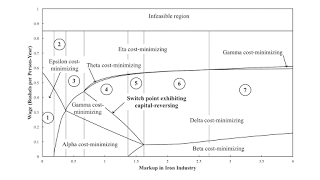Summary:
A Switch-Point Perturbation Diagram I have a new working paper at SSRN. Abstract: This article presents an analysis based on a comparison of stationary states. With technology and relative markups among industries taken as exogenous, the long-period trade-off between wages and rates of profits is determined. A long-period change in relative markups among industries can create a switch point exhibiting capital-reversing. Around such a switch point, a higher wage is associated with firms wanting to employ more labor for a given net output – a favorable occurrence for organized labor.
Topics:
Robert Vienneau considers the following as important: Example in Mathematical Economics, Labor Markets, Sraffa Effects
This could be interesting, too:
A Switch-Point Perturbation Diagram I have a new working paper at SSRN. Abstract: This article presents an analysis based on a comparison of stationary states. With technology and relative markups among industries taken as exogenous, the long-period trade-off between wages and rates of profits is determined. A long-period change in relative markups among industries can create a switch point exhibiting capital-reversing. Around such a switch point, a higher wage is associated with firms wanting to employ more labor for a given net output – a favorable occurrence for organized labor.
Topics:
Robert Vienneau considers the following as important: Example in Mathematical Economics, Labor Markets, Sraffa Effects
This could be interesting, too:
Robert Vienneau writes Austrian Capital Theory And Triple-Switching In The Corn-Tractor Model
Robert Vienneau writes Double Fluke Cases For Triple-Switching In The Corn-Tractor Model
Robert Vienneau writes The Emergence of Triple Switching and the Rarity of Reswitching Explained
Robert Vienneau writes Recap For A Triple -Switching Example

|
| A Switch-Point Perturbation Diagram |
I have a new working paper at SSRN.
Abstract: This article presents an analysis based on a comparison of stationary states. With technology and relative markups among industries taken as exogenous, the long-period trade-off between wages and rates of profits is determined. A long-period change in relative markups among industries can create a switch point exhibiting capital-reversing. Around such a switch point, a higher wage is associated with firms wanting to employ more labor for a given net output – a favorable occurrence for organized labor.
 Heterodox
Heterodox
